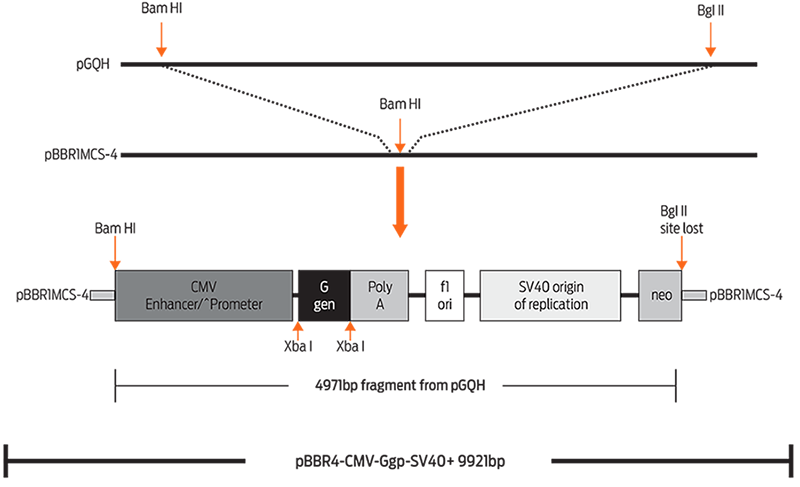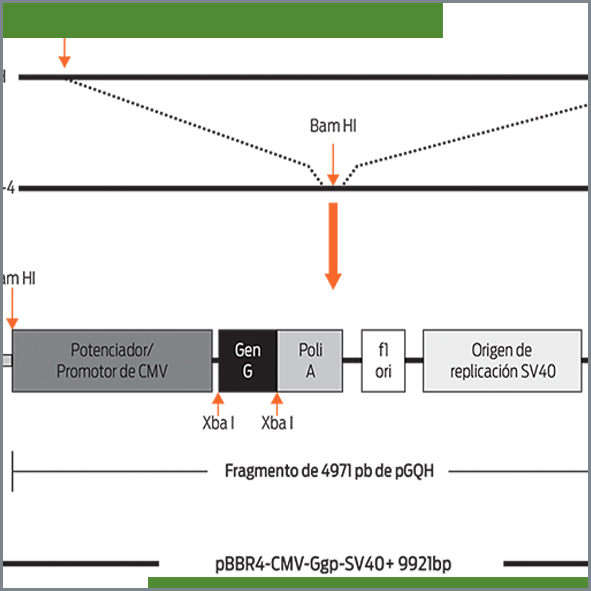Stability of the <em>B. abortus</em> S19 vaccine strain with a eukaryotic expression plasmid encoding the G glycoprotein from the rabies virus
Main Article Content
Abstract
Veterinaria México OA
ISSN: 2448-6760
Cite this as:
- Pazos-Salazar NG, Benitez-Serrano JC, Calderón-Chamorro JL, Hernández-Castro R, Díaz-Aparicio E, Aguilar-Setién JA. Stability of the B. abortus S19 vaccine strain with a eukaryotic expression plasmid encoding the G glycoprotein from the rabies virus. Veterinaria México OA. 2015;2(2). doi: 10.21753/vmoa.2.2.347.
Brucella abortus S19 is an intracellular vaccine strain against bovine brucellosis. Rabies is a lethal disease in cattle. Plasmids encoding the G glycoprotein from the rabies virus induce a protective immune response in different animal species. A vector called pBBR4-CMV-Ggp-SV40+, which encodes the G gene, regulated by the cytomegalovirus eukaryotic expression promoter, and which can be used to transform the B. abortus S19 vaccine strain, was constructed. The stability of the transformant strain was tested both in vitro and in vivo. In the in vitro assays, B. abortus S19 pBBR4-CMV-Ggp-SV40+ was grown for 5 sequential passages, and for the in vivo assays, female BALB/c mice were infected. Colony-forming unit counting and plasmid identification were performed in each passage and in the spleens at 7 days post-infection. To test the plasmid stability in the strain, all parameters were determined with and without antibiotic. The bacterial concentration was lower with antibiotic than without it, but the bacterial growth was more homogeneous. The plasmid was identified in antibiotic- and non-antibiotic-treated isolated colonies under both in vitro and in vivo conditions. The plasmid construct was also transfected into BHK-21 cells, which express the G glycoprotein. The B. abortus S19 pBBR4-CMV-Ggp-SV40+ strain showed stability, representing a suitable candidate vector for developing a bivalent vaccine against brucellosis and rabies. This is the first time that a Brucella species has been transformed with a eukaryotic expression plasmid.

Article Details
References
1) Arenas GN, Staskevich AS, Aballay A, Mayorga LS. 2000. Intracellular trafficking of Brucella abortus in J774 macrophages. Infection and Immunity, 68: 4255–4263.
2) Brodersen BW. 2014. Bovine viral diarrhea virus infections: manifestations of infection and recent advances in understanding pathogenesis and control. Veterinary Pathology, 51:453-464.
3) Comerci DJ, Pollevick GD, Vigliocco AM, Frasch ACC, Ugalde RA. 1998. Vector development for the expression of proteins in the vaccine strain Brucella abortus S19. Infection and Immunity, 66:3862-3866.
4) Cox JH, Dietzscold B, Schneider LG. 1977. Rabies virus glycoprotein. II. Biological and serological characterization. Infection and Immunity,16:754-9.
5) Crasta OR, Folkerts O, Fei Z, Mane SP, Evans C, Martino-Catt S, et al. 2008. Genome sequence of Brucella abortus vaccine strain S19 compared to virulent strains yields candidate virulence genes. PLoS ONE 3(5):e2193. doi:10.1371/journal.pone.0002193.
6) Díaz AE. 2013. Epidemiology of brucellosis in domestic animals caused by Brucella melitensis, Brucella suis and Brucella abortus. Scientific and Technical Review of the Office International des Epizooties, 32:43-51.
7) Dietrich G, Kolb-Maürer A, Simone S, Manfred S, Werner G, Ivaylo G. 2001. Gram-positive and Gram-negative bacteria as carrier systems for DNA vaccines. Vaccine, 19:2506–2512.
8) Elzer PH, Kovach ME, Phillips RW, Robertson GT, Peterson KM, Roop RM. 1995. In vivo and in vitro stability of the broad-host-range cloning vector pBBR1MCS in six Brucella Species. Plasmid, 33:51-57.
9) National Research Council. Guide for the care and use of laboratory animals. 2011. 8th edition. Washington, DC, USA: The National Academies Press.
10) Gurunathan S, Klinman DM, Seder RA. 2000. DNA vaccines: immunology, application, and optimization. Annual Review of Immunology, 18:927–974.
11) Johnson N, Aréchiga CN, Aguilar S.A. 2014. Vampire bat rabies: ecology, epidemiology and control. Viruses, 6:1911-1928.
12) Kovach ME, Elzer PH, Hill DS, Robertson GT, Farris MA, Roop RM, Peterson KM. 1995. Four new derivatives of the broad-host-range cloning vector pBBR1MCS carrying different antibiotic-resistance cassettes. Gene, 166:175-176.
13) Kuzmina NA, Kuzmin IV, Ellison JA, Rupprecht CE. 2013. Conservation of binding epitopes for monoclonal antibodies on the rabies virus glycoprotein. Journal of Antivirals and Antiretrovirals, 5:037-043.
14) Lee DN, Papes¸ M, Van Den Bussche RA. 2012. Present and potential future distribution of common vampire bats in the Americas and the associated risk to cattle. PLoS ONE 7(8):e42466. doi:10.1371/journal.pone.0042466.
15) Monath TP. 2013. Vaccines against diseases transmitted from animals to humans: a one health paradigm. Vaccine, 31:5321–5338.
16) Mukherjee F, Jain J, Grillo MJ, Blasco JM, Nair M. 2005. Evaluation of B. abortus S19 vaccine strains by bacteriological tests, molecular analysis of ery loci and virulence in BALB/c mice. Biologicals, 33:153-160.
17) Nicoletti P. 1990. Vaccination. In: Nielsen K, Duncan JR (eds.) Animal brucellosis. Boca Raton, FL, USA: CRC Press.
18) [NOM-062] Norma Oficial Mexicana [06 dic 1999]. NOM-062-ZOO-1999. Especificaciones técnicas para la producción, cuidado y uso de los animales de laboratorio. México: DOF-Sagarpa.
19) Pacheco WA, Genovez ME, Pozzi CR, Silva LMP, Azevedo SS, Did CC, Piatti RM, Pinheiro ES, Castro V, Miyashiro S, Gambarini ML. 2012. Excretion of Brucella abortus vaccine B19 strain during a reproductive cycle in dairy cows. Brazilian Journal of Microbiology, 43(2):594-601.
20) Perrin P, Jacob Y, Aguilar-Setién A, Loza-Rubio E, Jallet C, Desmézieres E, Aubert M, Cliquet F, Tordo N. 2000. Immunization of dogs with a DNA vaccine induces protection against rabies virus. Vaccine, 18:479-486.
21) Pizarro-Cerdá J, Méresse S, Parton RG, Goot GVD, Sola-Landa A, López –Goñi I, Moreno E, Gorvel JP. 1998. Brucella abortus transit through the autophagic pathway and replicates in the endoplasmic reticulum of nonprofessional phagocytes. Infection and Immunity, 66:5711-5724.
22) Ross BA, Favi CM, Vásquez VA. 2008. Glicoproteína del virus rábico: estructura, inmunogenicidad y rol en la patogenia. Revista Chilena de Infectología, 25:14-18.
23) Rupprecht CE, Plotkin SA. 2013. Rabies vaccines. In: Plotkin SA, Orenstein WA, Offit PA (eds.) Vaccines. 6th ed. The University of Pensilvania, PA, USA: Elsevier Saunders.
24) Sabio y García JV, Bigi F, Rossetti O, Campos E. 2010. Expression of MPB83 from Mycobacterium bovis in Brucella abortus S19 induces specific cellular immune response against the recombinant antigen in BALB/c mice. Microbes and Infection, 12:1236-1243.
25) Sabio y García JV, Farber M, Carrica M, Cravero S, Macedo GC, Bigi F, Sergio OC, Rossetti O, Campos E. 2008. Expression of Babesia bovis rhoptry-associated protein 1 (RAP1) in B. abortus S19. Microbes and Infection, 10:635-641.
26) Sangari FJ, Garcia-Lobo JM, Agüero J. 1994. The Brucella abortus vaccine strain B19 carries a deletion in the erythritol catabolic genes. FEMS Microbiology Letters, 121:337-42.
27) Schurig G, Sriranganathan N, Corbel M. 2002. Brucellosis vaccines: past, present and future. Veterinary Microbiology, 90:479-496.
28) Suman B, Samiran B, Umesh D, Pabitra HP. 2013. Bovine herpesvirus-1(BHV-1)–a re-emerging concern in livestock: a revisit to its biology, epidemiology, diagnosis, and prophylaxis. Veterinary Quarterly, 33(2):68-81.
29) Tesoro CE, Feria RIA, López MJG, Orozco SS, Hernández GR, Blanco FF, Pérez TA, Aguilar SJA. 2008. Efficient post-exposure prophylaxis against rabies by applying a four-dose DNA vaccine intranasally. Vaccine, 26:6936–6944.
30) Tesoro-Cruz E, Hernández-González R, Alonso-Morales R, Aguilar-Setién A. 2006. Rabies DNA vaccination by the intranasal route in dogs. Developmental Biology, 125:221–31.
License

Veterinaria México OA by Facultad de Medicina Veterinaria y Zootecnia - Universidad Nacional Autónoma de México is licensed under a Creative Commons Attribution 4.0 International Licence.
Based on a work at http://www.revistas.unam.mx
- All articles in Veterinaria México OA re published under the Creative Commons Attribution 4.0 Unported (CC-BY 4.0). With this license, authors retain copyright but allow any user to share, copy, distribute, transmit, adapt and make commercial use of the work, without needing to provide additional permission as long as appropriate attribution is made to the original author or source.
- By using this license, all Veterinaria México OAarticles meet or exceed all funder and institutional requirements for being considered Open Access.
- Authors cannot use copyrighted material within their article unless that material has also been made available under a similarly liberal license.



